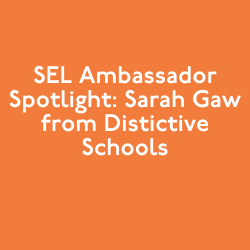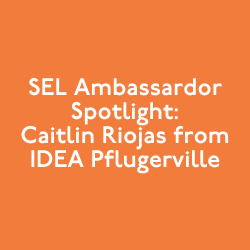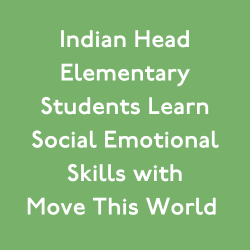Supporting social emotional learning in schools is truly a team effort. A culture of SEL doesn’t depend on just a strong guidance counselor or an enthusiastic principal. It takes a strong team and a coordinated effort to create a school culture of social emotional learning and school-wide systems of social emotional support.
We spoke with Vicki Robinson, CSW and social worker at Oquirrh Elementary School in Utah. As part of the school support team, Ms. Robinson works strategically with the school counselors, behavioral specialists, psychologists, and more to offer support for students – and they are seeing positive results. We connected with Ms. Robinson to learn more about the role of social workers on the school support team.

MTW: Tell us a little bit more about your background – what brought you to this work and how did you end up working in an elementary school?
Ms. Robinson: I appreciate this opportunity to share a little of my experience as a School Social Worker at Oquirrh Elementary School. My 6th grade teacher gave me an assignment to write about a profession I might want to pursue as an adult. I chose investigating child abuse. I graduated from college with a teaching degree, an undergraduate certificate in social welfare, a major in sociology and a minor in psychology. A few years ago, I earned a master’s degree in social work. I have spent most of my years of employment working with children and families at risk. I have taught youth-in-care both in a high school and in a residential treatment setting for our school district. I have provided therapy to both victims and perpetrators of sexual abuse and engaged in private counseling with people of all ages within my community and I did investigate child abuse for 6 years for the State of Utah. For me, being able to work in an elementary school is a grand privilege. We can’t start too early to help children learn how to navigate life and manage difficult and strong emotions. My husband and I have a large family and we have had children in school for decades. We believe that today’s children are facing greater challenges much earlier than any generation that preceded them.
Social workers are a recent addition to our School District. I was among the first four social workers to be assigned to an elementary school in twenty years. Prior to that, the social-emotional needs of our students were handled exclusively by school counselors and psychologists. When I arrived, I saw many wonderful programs and interventions that were already in place, but I also knew a school social worker could add to a school team. Additional members of our team included a behavior specialist, special education teachers, and a community service liaison, to name a few.
MTW: That sounds like such a robust school support team! How does your role differentiate from others on the team?
Ms. Robinson: Recently, I was interviewed to explain what makes social workers unique and how they differ from psychologists. We have many similar roles, but I feel the biggest difference is that we are trained to look at systems and how they influence the individual and how individuals and policies influence systems. Our focus is more than just identifying problems and providing a treatment plan but looking at the interplay of all factors that influence a child’s well-being. We look at societal trends and how the student’s family and school culture impact him [or her]. We may have a child that meets the criteria for ADHD, but not realize that those same symptoms can indicate significant trauma. We may have a child manifesting increasing symptoms of anxiety and aggression but learn that a video gaming addiction is fostering these symptoms more than genetics.
We will also need to consider if we are part of a trauma-infused system. Is the teacher evaluation system so anxiety-producing that teachers are more concerned about the evaluation than the needs of their students? Do teachers feel supported and safe? Do parents feel heard? Are they kept informed and are they a part of the decision-making process involving their child? Does our school have a formalized discipline flow chart, so everyone is aware of the consequences for certain behaviors and who [should] call home when there has been an incident involving a child.
Each school will establish a division of labor that meets their needs. At our school, the school psychologist spends a great deal of her time testing and overseeing students who have either a 504 plan or an IEP. I spend most of my time with children referred to as general education students.
MTW: What other kinds of school- or district-wide systems are in place to help your team be effective and create a culture of social emotional learning?
Ms. Robinson: Our school and district have done a great job of working together to provide integrated services to our students. I believe there are key components to a successful social emotional learning community, one being an effective school wide social emotional learning education program. We chose Move This World. This program has worked very well for us. It was a part of every classroom each morning and at the end of the day. I love that MTW gave every member of our school community a common language that we used in our individual and group counseling, school wide programs and in our Wellness Center, (the place where Oquirrh children who are feeling strong emotions coming on can go for 10 minutes to cool down and refocus). I cannot count how many times during group and individual sessions a child would use MTW vernacular to describe what they did to manage themselves during a difficult moment!
Our SEL Team and the Administration would rotate and visit classrooms and participate with the students. The school psychologist and I would also visit classrooms to offer additional SEL presentations in greater depth to further teach and promote these important SEL principles. As a SEL team we also visited weekly with our teachers at their PLC, (Professional Learning Community), meetings to keep updated as to the needs of their students. Referrals for additional services, that we refer to as Tier 2 and Tier 3 interventions, would come from teachers, parents, students, other members of our school staff and mentors from our Wellness Center. Because the Wellness Center takes data at each visit for each student, we could see which students were struggling the most and might need additional help. During Covid-19, we continued to gather remotely as a team of professionals to offer ongoing support and interventions to families.
Our school district has established a Wellness Team that is a tremendous support to schools and families. They provide mental health screenings free of charge. On their website, families can see a list of community resources and local mental health providers, their specialties and what insurance plans they accept. For those families with significant needs that find themselves without access to needed services, we can screen them for our Mental Health Access Program, MHAP, where there are monies earmarked to provide those services at no cost to the family. Our Wellness Team also has a team of clinical mental health providers that can assist families with support and counseling as needed. Our efforts during the last two years have reduced the number of office referrals dramatically. Other indicators of success are documented by less absenteeism and increased academic performance. Our goals include fostering hope, kindness, gratitude, and empathy. Recent research indicates that these character traits not only produce good chemicals in our brains but lead to post-traumatic growth. While we would love to create a problem free life for our students, that would make them ill-prepared for life. It is important to realize that challenges and trials are an inevitable part of life. As we work together; we can give our students a sense of empowerment and resilience to prepare them to meet all life challenges.
Thanks, Ms. Robinson, for being such a valued part of your school community and our MTW family! It’s clear how your role is impacting your school community by creating strong systems of support. Thanks for sharing your insights and experiences!
Social emotional learning is truly a team effort. By leveraging the experts in your building, and recruiting other experts from throughout the district, schools can provide meaningful support that impacts students throughout the school community, including their families.
Are you ready to implement social emotional learning in your district or school? Share your information and we’ll be in touch!
[pardot-form id=”263″ title=”MTW General Interest Form”]










